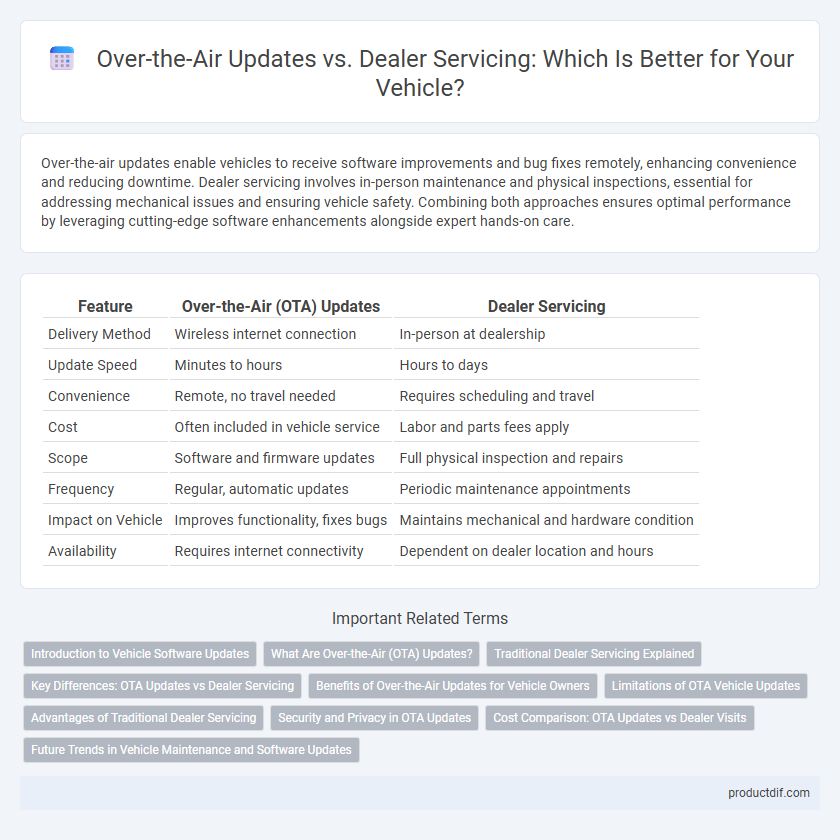Over-the-air updates enable vehicles to receive software improvements and bug fixes remotely, enhancing convenience and reducing downtime. Dealer servicing involves in-person maintenance and physical inspections, essential for addressing mechanical issues and ensuring vehicle safety. Combining both approaches ensures optimal performance by leveraging cutting-edge software enhancements alongside expert hands-on care.
Table of Comparison
| Feature | Over-the-Air (OTA) Updates | Dealer Servicing |
|---|---|---|
| Delivery Method | Wireless internet connection | In-person at dealership |
| Update Speed | Minutes to hours | Hours to days |
| Convenience | Remote, no travel needed | Requires scheduling and travel |
| Cost | Often included in vehicle service | Labor and parts fees apply |
| Scope | Software and firmware updates | Full physical inspection and repairs |
| Frequency | Regular, automatic updates | Periodic maintenance appointments |
| Impact on Vehicle | Improves functionality, fixes bugs | Maintains mechanical and hardware condition |
| Availability | Requires internet connectivity | Dependent on dealer location and hours |
Introduction to Vehicle Software Updates
Vehicle software updates enable manufacturers to improve functionality, fix bugs, and enhance safety features remotely through over-the-air (OTA) technology, eliminating the need for physical dealer visits. OTA updates provide faster deployment and convenience, supporting real-time enhancements to vehicle systems such as infotainment, engine management, and advanced driver-assistance systems (ADAS). Dealer servicing, while traditionally essential for hardware-related maintenance, is increasingly supplemented by OTA updates that optimize software performance without interrupting vehicle use.
What Are Over-the-Air (OTA) Updates?
Over-the-Air (OTA) updates enable vehicles to receive software improvements and bug fixes remotely via wireless internet connections, eliminating the need for physical dealer visits. These updates enhance vehicle systems such as infotainment, navigation, safety features, and engine performance with greater convenience and reduced downtime. Automakers like Tesla, Ford, and General Motors leverage OTA technology to deliver timely enhancements, improve cybersecurity, and extend the lifespan of vehicle components efficiently.
Traditional Dealer Servicing Explained
Traditional dealer servicing involves scheduling maintenance appointments, physically bringing the vehicle to authorized service centers, and relying on technicians to diagnose and repair issues using specialized tools. This process can result in longer wait times and higher labor costs due to manual diagnostics and parts replacement. Dealers also provide warranty-covered repairs and recall services that are not always accessible via over-the-air updates.
Key Differences: OTA Updates vs Dealer Servicing
Over-the-air (OTA) updates enable seamless, wireless software enhancements directly to vehicles, eliminating the need for physical dealer visits and reducing downtime. Dealer servicing involves manual diagnostics, repairs, and software updates performed by technicians, often requiring scheduling and longer wait times. OTA updates prioritize convenience and continuous improvement, while dealer servicing addresses comprehensive maintenance and hardware-related issues.
Benefits of Over-the-Air Updates for Vehicle Owners
Over-the-air (OTA) updates provide vehicle owners with the convenience of remotely upgrading software without the need for dealership visits, reducing downtime and travel costs. OTA technology enhances vehicle performance and safety by delivering timely improvements and security patches directly to the car's system. This seamless update process supports real-time diagnostics and feature enhancements, promoting a continuously optimized driving experience.
Limitations of OTA Vehicle Updates
Over-the-air (OTA) vehicle updates offer convenience but face limitations such as restricted bandwidth, which can delay large software installations and impact update speed. Security concerns arise from potential cyberattacks during wireless transmission, necessitating robust encryption and authentication protocols. Furthermore, OTA updates cannot address mechanical repairs or hardware malfunctions, requiring traditional dealer servicing for comprehensive vehicle maintenance and diagnostics.
Advantages of Traditional Dealer Servicing
Traditional dealer servicing offers personalized diagnostics and repairs by certified technicians, ensuring precise maintenance tailored to specific vehicle models. Dealers provide comprehensive inspections, warranty-covered parts, and access to manufacturer recalls, enhancing vehicle reliability and safety. Face-to-face interaction allows immediate feedback and trust-building, which is crucial for complex mechanical issues beyond software updates.
Security and Privacy in OTA Updates
Over-the-air (OTA) updates enhance vehicle security by enabling timely patches for software vulnerabilities without requiring physical dealer visits, reducing exposure to unauthorized access during service intervals. Advanced encryption protocols and multi-factor authentication safeguard data integrity and privacy throughout the OTA transmission process, ensuring that sensitive vehicle and user information remains protected from cyber threats. Dealer servicing often involves manual software updates that can increase the risk of data breaches due to inconsistent security measures and physical device handling.
Cost Comparison: OTA Updates vs Dealer Visits
Over-the-Air (OTA) updates significantly reduce the cost of vehicle maintenance by eliminating the need for physical dealer visits, which often include labor charges averaging $100 to $150 per hour. OTA updates can be deployed remotely at minimal expense, enabling manufacturers to provide timely software improvements and bug fixes without incurring the overhead of dealer infrastructure. This cost efficiency results in substantial savings for both automakers and consumers, enhancing vehicle performance and security at a fraction of traditional dealer servicing costs.
Future Trends in Vehicle Maintenance and Software Updates
Over-the-air (OTA) updates are transforming vehicle maintenance by enabling manufacturers to remotely deploy software improvements, security patches, and new features without requiring physical dealership visits. Future trends indicate a significant shift towards OTA solutions driven by the growth of connected vehicles, enhanced cybersecurity protocols, and increased consumer demand for convenience and real-time enhancements. Integrated cloud platforms and artificial intelligence will further optimize predictive maintenance, minimizing downtime and elevating overall vehicle performance.
Over-the-Air Updates vs Dealer Servicing Infographic

 productdif.com
productdif.com